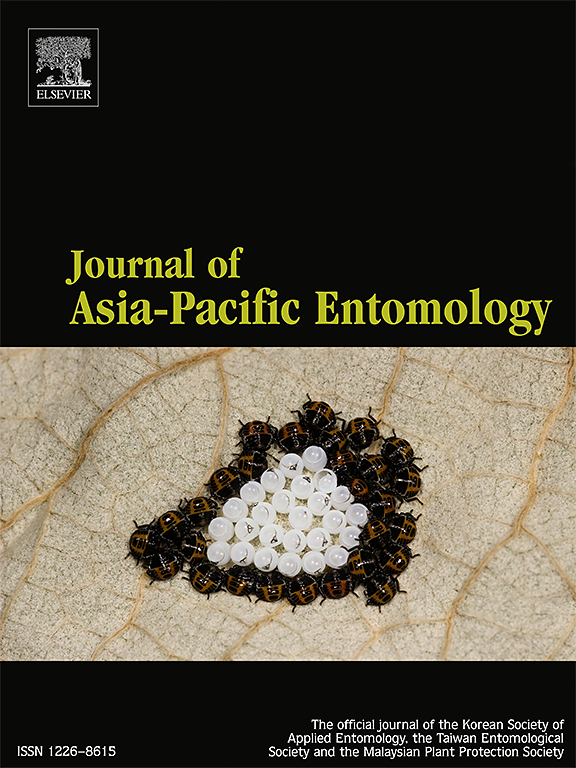Pheromone biosynthesis activating neuropeptide induces attractant production in female adults of Bemisia tabaci (MED)
IF 1.1
3区 农林科学
Q3 ENTOMOLOGY
引用次数: 0
Abstract
Bemisia tabaci is a polyphagous pest that is distributed worldwide and transmits various viruses, including tomato yellow leaf curl virus, tomato chlorosis virus, pepper whitefly-borne vein yellows virus and so on. We analyzed the transcriptome of B. tabaci and identified pheromone biosynthesis activating neuropeptide (PBAN) gene from female adults. Like other hemipterans, Bta-PBAN harbored four neuropeptides (DH-like peptide, PBAN, β-SGNP, and γ-SGNP). The artificial Bta-PBAN was injected into female adults, and compounds were extracted using hexane. Subsequently, GC–MS analysis was performed to identify putative attractants from the extracted compounds. Totally 22 compounds were up-regulated after artificial Bta-PBAN injection. Among them, 2-ethylhexanoic acid (2-EHA) and phytol were selected as putative attractants of B. tabaci adults. 2-EHA and phytol showed the highest attraction rate at 10% and 30% concentration, respectively. However, their attractancy did not depend on the concentration. This research is the first report on identifying attractants derived from B. tabaci. These results suggest that 2-EHA and phytol can be used as attractants for B. tabaci.

信息素生物合成激活神经肽诱导烟粉虱雌成虫产生引诱剂
烟粉虱是一种多食性害虫,分布在世界各地,传播多种病毒,包括番茄黄卷叶病毒、番茄褪绿病毒、辣椒白蝇传播的脉黄病毒等。我们分析了烟粉虱的转录组,并从雌性成虫中鉴定了信息素生物合成激活神经肽(PBAN)基因。与其他半肽一样,Bta-PBAN含有四种神经肽(dh样肽、PBAN、β-SGNP和γ-SGNP)。将人工Bta-PBAN注射到雌性成虫体内,并用己烷提取化合物。随后,GC-MS分析从提取的化合物中鉴定推定的引诱剂。人工注射Bta-PBAN后,共有22个化合物表达上调。选取2-乙基己酸(2-EHA)和叶绿醇作为烟粉虱成虫的引诱剂。2-EHA和叶绿醇分别在10%和30%的浓度下吸引率最高。然而,它们的吸引力并不取决于浓度。本研究是鉴定烟粉虱引诱剂的首次报道。结果表明,2-EHA和叶绿醇可作为烟粉虱的引诱剂。
本文章由计算机程序翻译,如有差异,请以英文原文为准。
求助全文
约1分钟内获得全文
求助全文
来源期刊

Journal of Asia-pacific Entomology
Agricultural and Biological Sciences-Insect Science
CiteScore
2.70
自引率
6.70%
发文量
152
审稿时长
69 days
期刊介绍:
The journal publishes original research papers, review articles and short communications in the basic and applied area concerning insects, mites or other arthropods and nematodes of economic importance in agriculture, forestry, industry, human and animal health, and natural resource and environment management, and is the official journal of the Korean Society of Applied Entomology and the Taiwan Entomological Society.
 求助内容:
求助内容: 应助结果提醒方式:
应助结果提醒方式:


